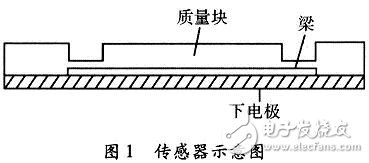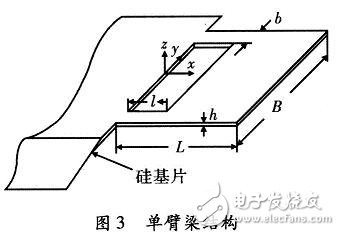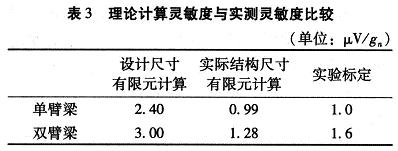Silicon micro-acceleration sensor is an important branch of MEMS devices and has a very broad application prospect. Because the silicon micro-acceleration sensor has the advantages of fast response, high sensitivity, high precision, and easy miniaturization, and the sensor can work normally under the action of strong radiation, it has developed rapidly in recent years. Compared with foreign countries, domestic research on silicon micro-sensors started late, and the work done mainly focused on the processing and theoretical research of silicon micro-acceleration sensors. In this paper, the double-end fixed-branch silicon micro-acceleration sensor is taken as the research object, and its performance is simulated by Aasys software to select the structural form with excellent performance.
1 sensor structure and working principle
The piezoresistive accelerometer is the earliest developed silicon micro-acceleration sensor. The structural form of the elastic component is generally formed by micromachining technology to form a silicon beam plus mass, and the piezoresistive effect is used to detect the acceleration. In the double-ended fixed beam structure, the mass moves up and down like a piston, and the schematic diagram of the sensor in the form of the structure is shown in FIG.

2 piezoresistive accelerometer
The piezoresistive accelerometer is the earliest developed silicon micro-acceleration sensor, and it is also one of the most used currently. In the early 1980s, after Stanford University's Roylance and Angell published the first article on silicon micro-acceleration sensors, all-silicon sensors began to appear. With the deepening of the research on the principle of silicon micro accelerometer and the diversity of process realization, the types of silicon micro-acceleration sensors are becoming more and more diverse. Various silicon micro-accelerometers are used in different occasions. The research on silicon micro-accelerometers is also increasing. The more people come to the attention.
The piezoresistive accelerometer has small volume, wide frequency range, wide measuring acceleration range, direct output voltage signal, no complicated circuit interface, low price in mass production, good reproducibility, and direct measurement of continuous acceleration and Steady-state acceleration, but large drift to temperature, is also sensitive to mounting and other stresses, and it does not have the accuracy required for some low gn measurements.
3 piezoresistive silicon micro-acceleration sensor structure
3.1 Structural form
The elastic components of the piezoresistive accelerometer generally use a silicon beam plus a mass, the mass is supported by the cantilever beam, and a resistor is formed on the cantilever beam to be connected to the measuring bridge. Under the action of inertial force, the mass moves up and down, and the resistance of the resistance on the cantilever beam changes with the action of the stress, which causes the output voltage of the measuring bridge to change, thereby measuring the acceleration.
There are many typical structures of piezoresistive silicon micro-acceleration sensors, such as cantilever beam, double-arm beam, 4-beam and double island-5 beam. The structural form and size of the elastic element determine the sensitivity, frequency response, range, etc. of the sensor. The mass can make the stress on the cantilever beam larger under the action of less acceleration, and improve the output sensitivity of the sensor. At large accelerations, the effect of the mass may cause the stress on the cantilever to exceed the yield stress and the deformation to be too large, causing the cantilever beam to break. For this reason, the high gn value acceleration is intended to be a structural form of a single arm beam and a double arm beam having the same mass and beam thickness, as shown in FIGS. 2 and 3.


3.2 Finite element model of beam structure
Aasys is a comprehensive finite element software that can be used on a microcomputer and is a finite element analysis software widely used in MEMS design. Through the analysis and calculation of finite element, the gravitational distribution, natural frequency and measurable maximum acceleration of the cantilever beam can be predicted, and then the selection of beam structural parameters can be guided. After the calculation and analysis of the finite element of the beam structure, the structural parameters of the single-arm beam and the double-arm beam are selected, as shown in Table 1.

From the finite element calculation results, the average stress on the piezoresistive element under the acceleration of 10 000gn on the single-arm beam and the double-arm beam can be obtained, as shown in Table 2.

4 piezoresistive silicon micro acceleration sensor processing technology
The cantilever beam of the piezoresistive sensor is usually formed by epitaxial growth of an epitaxial layer on a silicon wafer by a CVD process. In this paper, a piezoresistive acceleration sensor is manufactured by a bonding process. The advantage of the bonding process is that a high quality epitaxial layer can be obtained, and the thickness of the cantilever beam is easily ensured by the silicon wafer thinning process, and the fine silicon wafer is polished on one side, and the thickness error can be controlled within 0.5 μm; Electrochemical self-stop corrosion is required, and the corrosion rate of SiO2 by the EPW etching solution is extremely slow, so that the etching process stops on the SiO2 layer, thereby ensuring that the thickness of the silicon wafer after thinning is the thickness of the elastic beam. The sensor chip size is 3 mm & TImes; 5 mm and is packaged in a ceramic tube. An n-type silicon wafer was selected, crystal orientation (100), diameter 50 mm, thickness 300 μm, and resistivity 5-12 Ω·cm.
5 Acceleration sensor performance test and result analysis
5.1 Impact test
High gn-value silicon micro-accelerometers have very low sensitivity, and there is almost no signal output at small accelerations. Only when an impact test is performed can the performance be verified. For this reason, the impact test at room temperature was carried out on a Mahit hammer.
The standard sensor and the calibrated sensor are simultaneously fixed on the hammer head of the Mahit hammer, and the impact sensor samples of the single-arm beam and the double-arm beam structure are respectively subjected to impact test under different tooth numbers. The overload test can reach 12 000 gn without failure, and the acceleration sensor impact test range is up to 2 500 gn.
5.2 Analysis of test results
Through the analysis of the relationship between the output voltage and the acceleration of the tested acceleration sensor, it basically belongs to the linear relationship, and the linear data of the tested sensor data is fitted by the linear regression model. The result is shown in Fig. 5.

For the silicon micro-acceleration sensor with cantilever structure, the thickness of the beam has the greatest influence on the sensitivity of the acceleration sensor under the same structural dimensions, which is basically inversely proportional. This is because under the same load, the beam thickness is inversely proportional to the stress, and the stress directly affects the sensitivity. The greater the stress, the higher the sensitivity. Since the thickness of the processed chip beam is larger than the design value, the test sensitivity is smaller than the design value, as shown in Table 3.

In the case of a certain mass size, the length of the beam - proportional to the sensitivity, the width of the beam is inversely proportional to the sensitivity. In the case of a certain size of the beam, the mass of the mass is proportional to the sensitivity.
LED flexible neon is the latest and most popular LED breakthrough product, which makes up for the shortage of glass neon tube and fiber. LED flexible neon is a professional linear lighting decoration product. Although it looks like glass neon tube, it can be bent at will. It has shatterproof and waterproof functions. It can be used indoors and outdoors.
Led Neon Flex Rope Light,Neon Flex Rope Lights,Neon Flex Sign,Led Neon Flex
Shenzhen Oleda Technology Co.,Ltd , https://www.baiyangsign.com